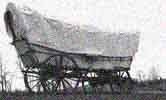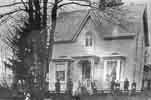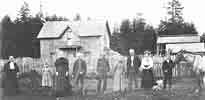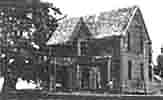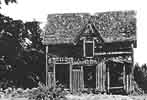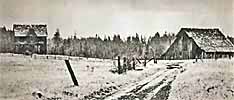George
Washington Bush was born on the east
coast of American, the son of an Irish
house maid and a man servant from India.
Little is known about his early life,
but some writers say that, as a young
man, George may have come to the west
with the early fur trappers. In later
years, he became a successful Missouri
farmer and cattleman.
But in those days, before the Civil
War, laws regarding the rights of his
people to own land and property were
in question, so in his later years
George led the Bush family to a new
beginning in the Oregon County.
Bush was near 60 in 1843 when he
planned the long move west. He was
still tall and strong, though
soft-spoken and gentle. With his
German wife, Isabelle, and their
family, the Simmons and McAllister
families, and two bachelors, the
westward group numbered about 23
persons.
Many stories have been told about
this migration, known as the
Bush-Simmons party. Some writers say
that George paid for most of the
supplies and even bought wagons for
his friends who were financially less
fortunate. Others say he had a special
wagon built with a false bottom in
which he hid a small fortune in
silver, which had been left by his
father, who had inherited it from his
employer. We do know that the Bush
family had six wagons, each requiring
about $1000 to outfit. All six had
been carefully and thoughtfully
stocked with provisions enough to last
a year.
Always a kind and generous person,
George responded without hesitation
when he saw that the supplies of other
members of his party were dwindling.
He and Isabelle gladly shared their
own stores, even to the point of
sacrifice.
After seven months of travel, the
Bush-Simmons party arrived at their
destination, The Dalles, Oregon
Territory. To their dismay, they were
told that laws had just been passed
denying blacks the right to live in
the Territory. Although the white
families could have stayed, they would
not desert their black friend, so the
entire group decided to move north of
the Columbia River where there was
little likelihood the new law would be
enforced.
During the winter of 1844, the party
stayed near Ft. Vancouver and the men
worked in a sawmill run by the
Hudson’s Bay Co. In the spring,
Michael T. Simmons led a scouting
party to the Puget Sound country and
was convinced this was a perfect place
for his friends to settle. Dr. John
McLoughlin arranged for the Company
post at Nisqually to loan whatever
supplies might be necessary for the
establishment of homesteads, even
though this would be aiding the
American settlement of what was then
considered British territory. Since no
crops could be harvested during that
first year, help from the Hudson’s Bay
Co. made survival possible.
The Bush family’s farm was
established near what is now the
Olympia Airport. With his sons’ help,
George developed his lands into one of
the most successful claims in the
region. Isabelle also proved to be an
able farmer. She was so successful in
poultry raising, she was able to
barter young turkeys with Dr. Tolmie
of Ft. Nisqually. He gave her one
young ewe in trade for each turkey and
thus the Bush sheep herd was begun.
George and Isabelle maintained
friendly relations with the Indians of
the Sound area, and Isabelle was able
to use her training as a nurse to
remedy their ills. The Indians
returned their kindness during the
uprising of 1855-56.
Tribal leaders promised that no
settler would be harmed while on the
Bush property. In the fort which had
been erected with the help of several
families, George once again shared his
food with frightened settlers who came
to him for help, and Isabelle’s
nursing skills were put to use. But
the Indians kept their word, and
nothing was harmed on the Bush
property. George’s desire was to
secure land which would ensure his
family’s future – land which could
never be taken from them because of
their race.
In 1854, the United States Congress
granted Bush his original claim of 640
acres of land. Although they did not
realize it at the time the
Bush-Simmons settlers also helped to
secure the Washington area for the
United States.
There are those who fell that if
George Bush had not been driven from
The Dalles area because he was
considered to be a black, the land
north of the Columbia River might have
remained unsettled by Americans for
unknown years, and the British might
have been granted the area which we,
today, call Washington.
George Bush was truly an inspiration
to all who had known him.

